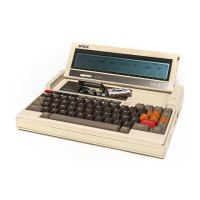When the PX-S
is
in the numeric keypad mode the LED at the top
of
the key-
board marked
"NUM"
will be lit. Pressing this key together with the
1
SHIFT
1 key when the PX-S
is
in this mode returns to the normal state.
c) Special keys
There are a number
of
special keys some
of
which allow control
of
the cursor
and also simplify operation
of
the PX-S. Some
of
them also allow interruption
of
the computer so that, for example, the screen can be dumped
to
a printer.
The CURSOR KEYS are the keys marked with arrows on the right
of
the key-
board. They are used to move the cursor
on
the screen under control
of
the
applications program. As was seen in the initialization, they may not all be ac-
tive at once and may only allow movement within certain limits. The cursor
keys are not supported by
CP/M.
1
RETURN
I:
This means carriage return, and
is
normally used to place the cur-
sor at the beginning
of
a line. Since this would place the cursor
on
top
of
the
characters already printed, a line feed
is
normally added to a carriage return
by the software. The
1
RETURN
1 key
is
also used
to
signal the end
of
entry when
a sequence
of
characters are being entered into the computer, otherwise the soft-
ware has no way
of
knowing when the user has finished. Until the carriage return
character
is
entered, the software will wait for the next character, unless a sin-
gle
character entry
is
required. The ASCII code for a carriage return
is
13
decimal
(OD
hexadecimal), which corresponds to a 1
CTRL
1-
IMl
.
1
STOP
I:
In
CP/M
pressing this key clears the keyboard buffer and makes
a warm start
of
the system. In BASIC it
is
used
to
stop a program.
1
CTRL
1 and 1
STOP
I:
Pressing these keys simultaneously immediately terminates
I/O
operation, and makes a warm start
of
the system.
1
ESC
I:
Pressing this key enters
an
ESCAPE code (ASCII code
27
decimal).
It
is
used frequently
to
exit from many
of
the special function programs
of
the
PX-S.
1
PAUSE
1 : Pressing this key enters a PAUSE code (ASCII code
19
decimal) which
can be used
to
stop printing to the screen. For example
if
there are too many
files
on
a disk
to
be displayed on the screen
at
one time pressing thel
CTRL
Ikey
can temporarily stop the printing
of
the filenames. The effect
of
a pause can
be reversed by pressing any other key.
2-14
1
CTRL
1 and 1
ESC
1 or 1
PAUSE
1 : Pressing the 1
CTRL
1 and 1
ESC
1
or
[PAUSE]
keys calls
a subroutine specified.
1
HELP
I:
Pressing this key enters al
HELP
Icode (ASCII code 0). This is some-
times used in applications software
to
show a table
of
commands etc. On the
PX-S the main use
of
the key is in combination with the 1
CTRL
1 key
to
enter
the System Display.
1
CTRL
1 and 1
HELP
I:
Pressing these keys simultaneously turns
on
the System
Display. This
is
described in full in section 2.2.2.a.
1
TAB
I:
This
is
a key which moves the cursor
to
pre-set positions across the
screen. These are normally in steps
of
S characters. When the TAB key
is
pressed
it generates an ASCII code 9.
~:
Pressing this key enters
a~character
(ASCII code
127
decimal).
It
is
usually used to delete the character under the cursor. However, some ap-
plication programs use it in different ways.
It
has a special use on the
CP/M
command line and this will be explained in Chapter 3.
1
CLR
I:
This
is
obtained by
USi,g
the
IL~
key with
the[QKJkey.
Both
keys must be pressed even
if
the
~~~
key
is
active.
It
enters a -
which has the ASCII code
12
decimal.
If
used in
an
applications program it
normally clears the screen.
1
INS
I:
Pressing this key enters
an
ASCII code
IS
decimal. Normally this
is
used
to
allow characters
to
be inserted. Its use
on
the
CP/M
command line
is
described in Chapter 3, as it has a different function.
1
SCRN
I:
This key
is
used
to
change the cursor tracking mode. The PX-S dis-
plays a window on a virtual screen. The cursor moves over the virtual screen.
Normally the window follows the cursor. This
is
called tracking mode. The
key (obtained by pressing the
1
INS
1 and 1
SHIFT
1 key)
is
used to turn the track-
ing mode on and off.
If
thel
SCRN
Ikey
is
pressed while the PX-S
is
in tracking
mode, the window will be frozen over a particular portion
of
the virtual screen.
This
is
known as the non-tracking.mode. Pressing thel
SCRN
Ikey
when the PX-S
is
in this mode will turn the tracking mode
on
again and move the window
on
the virtual screen so that the cursor
is
displayed in the window.
rID:
This key causes the cursor to Back -Space and delete the last charac-
ter. It enters a BACKSPACE character (ASCII code
S).
In
some applications
2-15

